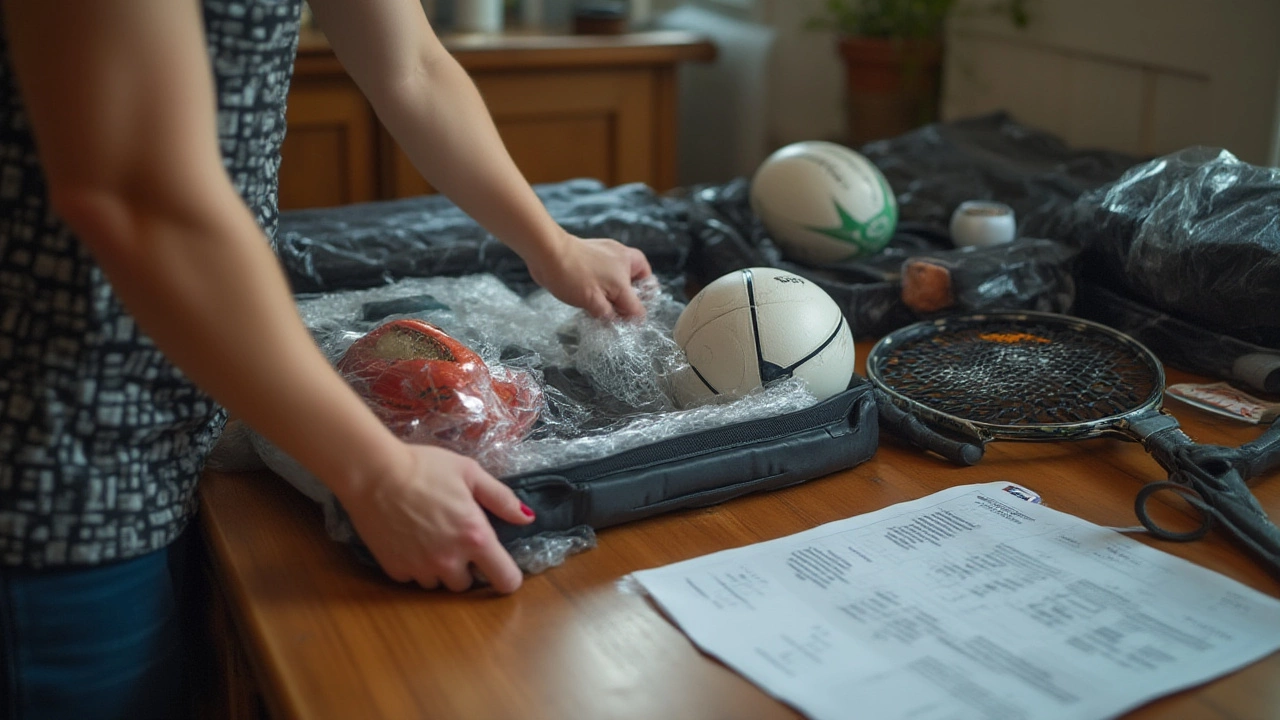Can You Take Sports Equipment on a Plane? Rules, Tips, and Surprises
Ever been that person trying to squeeze a tennis racket into an overhead bin? Or maybe you’ve watched someone at the check-in desk desperately argue that their fishing rod somehow counts as a regular carry-on. Flying with sports equipment isn’t just about finding space in your bag—it’s a puzzle of airline rules, fees, and outright surprises. What counts as “sports equipment” anyway? Can you really pack a set of golf clubs or a surfboard without a second mortgage? Let’s unpack the real rules and insider strategies for getting your beloved gear from your driveway to your destination intact, and without a meltdown at security.
Understanding Airline Policies on Sports Equipment
Every airline plays by its own playbook when it comes to bringing sports equipment onboard or even loading it onto the plane. While airlines like Delta, Emirates, and Qantas boast about their traveler-friendly baggage policies, that friendliness gets tested the minute you mention a snowboard or kayak paddle. Here’s the kicker: what’s allowed on one airline may get you a cold rejection at another. Sports equipment covers everything from skis to fencing foils, bikes, and cricket bats—and every piece comes with specific rules on size, weight, and how you have to pack it.
Some airlines see sports gear as standard checked baggage if it fits their regular weight and size rules (often 23–32 kg, max 158 cm linear dimensions), but others slap on ‘oversized’ or ‘special item’ stickers, plus extra fees. For example, United treats golf bags as regular checked luggage within their size and weight limits, while budget airlines like Ryanair can charge €50 or more per item—sometimes each way. American Airlines posts a detailed chart online about which items go free (fishing rods, archery gear), and which cost sky-high fees (canoes and kayaks, sorry paddlers!).
Here’s a look at how a few major airlines handle the situation:
| Airline | Allowed as standard bag? | Extra charges |
|---|---|---|
| Delta | Many common items (golf, tennis, hockey) | Oversize/overweight fees if over limits |
| British Airways | Sports equipment counts as standard bag, if under 23 kg/190 cm | Standard baggage fees, excess if over |
| Lufthansa | Free for common items, but must reserve sports bag space ahead | €50–€150 for big or unusual items |
| Qantas | Included in checked bag allowance (except very large gear) | Oversize fees for large equipment |
| Ryanair | No, must pay sports equipment fee | €50–€75 per item, per flight |
Want to travel with a bicycle? Most airlines require it to be packed in a hard case, have the handlebars turned, and the tires partially deflated. Carrying a cricket bat or tennis racket as a carry-on? Usually, you’re out of luck—their awkward shape means they have to go in the hold. There’s endless variety: Singapore Airlines says skimboards are fine but oversized surfboards over 277 cm get turned away entirely. Bottom line? Check your airline’s ‘special baggage’ rules directly—not on a travel forum or third-party site. Real stories on Reddit reveal how even gate agents sometimes get the details wrong, leading to tense debates.
“Each airline’s sports equipment policy is notorious for complexity, so always read the fine print and call the airline before booking, especially for anything larger than a tennis bag.” – The Points Guy
Don’t forget international connections. Flying from San Diego to Sydney with a surfboard? Even if the first airline says yes, your connecting airline might say no. One pro surfer told The Guardian about being stranded in Tokyo, forced to buy a new shortboard after her original one was rejected by a regional carrier. That’s a $700 lesson you won’t want to learn firsthand.
What Equipment Can You Actually Carry On?
So what sports gear can you genuinely carry on the plane with you? Short answer: not much. Most airlines—regardless of how generous they seem—have strict cabin size rules. That means most gear heads to the hold. Baseball gloves, a couple of tennis balls, or yoga mats might slip by as part of your personal item, but rackets, bats, axes (yes, for axe-throwing hobbyists!), and sticks are a hard no for obvious safety reasons.
Security agencies like the TSA in the U.S., and the European Union’s aviation authorities, have their own long lists of forbidden carry-on sports items. Anything that can double as a bludgeon or blade gets banned, in addition to items that look suspicious on an X-ray. A skateboard? Sometimes you can carry it if it fits in the overhead bin—but a ski pole or golf club, no matter how tightly wrapped, will get you a trip back to the check-in desk. TSA’s public list gets pretty wild, mentioning fencing swords, hockey sticks, and even lacrosse sticks as checked baggage only.
- Baseball bats: Checked only
- Guns/replica weapons (including paintball, airsoft): Declared and checked, unloaded and in locked container
- Bows and arrows: Checked baggage only
- Diving tanks: Must be empty, regulator removed—checked only
- Fishing rods: Sometimes allowed in the cabin if collapsible and within size limit, but rare
- Yoga mats: Usually fine as a personal item
- Football/Soccer balls: Deflated, can be in cabin if fits size and weight requirement
There are actual horror stories, like the guy who tried to carry a fencing foil onto an international flight out of LAX—he ended up missing his flight and having to pay $150 for a late baggage check. Then there are those “grey areas” airlines never really clarify, like lacrosse sticks or polo mallets. If you’re not sure, call the airline and take screenshots of their policy page. You could be the next case study in a travel horror thread if you wing it.
Packing your equipment is another landmine. Something as fragile as a fishing rod or archery bow will need a hard-sided container—and many airlines specify approved types, like rigid sky cases for skis. Some travelers swear by packing their racquets or bats inside their regular suitcase, tightly wrapped in soft clothes, but this is risky. Oversized musical instrument? Oddly, airlines are sometimes much more accommodating—go figure! Maybe drumsticks are less scary than baseball bats.

Packing, Protecting, and Declaring Your Gear
Packing sports equipment for air travel is a real test of patience, creativity, and resourcefulness. Airline staff aren’t going to baby your gear, no matter how many “fragile” stickers you slap on your snowboard bag. The golden rule: pack like your life depends on your kit arriving intact, because it almost does. Hard-sided cases are a smart investment for any rigid or expensive items—think skis, bikes, and golf clubs. Look for cases with proper foam padding, tight latches, and secure wheels. If you’re traveling with team gear or a lot of stuff, consider shrink-wrapping whole bags at the airport for extra protection (big teams do this a ton).
There’s real data to back this up. According to the U.S. Department of Transportation’s 2023 baggage statistics, sports equipment cases were twice as likely to be mishandled as regular suitcases. The most common culprit? Padded soft cases that looked sturdy, but caved in under the weight of other luggage. I met a marathon runner who wrapped her racing wheelchair in two rolls of bubble wrap and a tarp, only to arrive in London to find it with a cracked frame and a ‘Sorry’ sticker from the baggage crew. Ouch.
Other essentials before checking in:
- Weigh your gear before you leave home (kitchen scales work great for lighter items, bathroom scales for big bags). Airlines are strict about limits, usually 23 kg for economy.
- Print out a list and photos of your items to show if your gear goes missing. Serial numbers are handy, especially for bikes.
- Get special travel insurance for expensive or hard-to-replace gear. Regular baggage coverage often maxes out at $500–$1,000 per bag.
- If you have connecting flights with multiple airlines, double-check that your sports gear will actually get transferred correctly. Lost surfboards and golf bags are a running joke among baggage handlers, but it stops being funny if it happens to you.
- Declare any restricted items at check-in. This is crucial for things like starter pistols, CO2 cartridges, or archery arrows. Don’t test your luck with customs.
If you’re traveling internationally, pay attention to customs restrictions. Bringing a javelin into Australia? It’s treated as an “imported weapon” and must be declared—otherwise, it could end up confiscated, or worse, land you a fine. For the quirky stuff, like capoeira sticks or curling stones, call ahead. Airlines and customs often don’t know what you’re talking about, so the more details and paperwork you have, the smoother it’ll go. And always get there early—oversized baggage takes longer to check in and, sometimes, gets a separate security screening.
Fees, Loopholes, and Clever Workarounds
If you’re picturing hauling your precious snowboard bag through the airport without getting stung with surprise costs, you’re not alone. The real shock comes when you see what airlines charge for equipment that doesn’t fit their usual rules. These fees swing wildly. On legacy carriers (think British Airways, Air Canada), you might get lucky and roll your golf clubs into your free checked bag allowance. But low-cost carriers? You’ll pay dearly—think $30–$150 per piece, often more if booking last minute.
Here’s how to dodge some of the worst fees or at least soften the blow:
- Book in advance: Some airlines cut the cost of equipment fees by half if you add your gear online when booking, instead of at the airport.
- Check loyalty programs: If you fly a lot, being a frequent flyer or premium credit card holder can land you one or two checked bags free—even for odd-shaped gear.
- Combine baggage: Some sports equipment (like folding bikes, cricket pads) can fit into a regular suitcase. If you keep it under weight/size limits, you may not be charged extra at all.
- Use package deals: Golf and ski resorts often partner with airlines for bulk baggage deals. Ask ahead—sometimes you get equipment shipped direct to your hotel for less than the cost of an overweight bag.
- Lightweight options: Think about renting at the destination. Instead of dragging skis, check the resort rental rates and quality—sometimes it’s worth the money to skip the risk and hassle.
And those quirky loopholes? A rugby fan I met got around oversize fees by wrapping his kit as “team equipment” and checking it as a community group, which scored him a big group discount. Others double up personal and checked bag allowances by packing lightweight gear inside their regular suitcase and heavier stuff in the “sports bag,” but be careful—airline agents love to call out sneaky tricks.
Some final hard truths: no airline covers everything, even if you pay through the nose. Always take lots of pictures of your equipment at check-in, and keep all the documentation. If you need to file a claim for lost or damaged sports equipment, you’ll want every bit of proof. Travelers usually don’t win against the airline, unless they have ironclad evidence the damage wasn’t their fault.
Flying with sports equipment isn’t just about moving your stuff—it’s practically an extra sport in itself. Know the rules, pack smart, check for loopholes, and brace for surprises. And keep one thing in mind: your precious gear is precious to you, not the airline. So treat every journey like the playoffs and plan for a few curveballs along the way.









